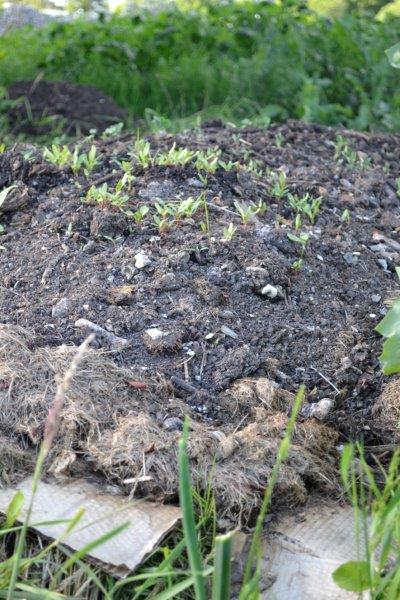By: Sue Bradley
Fancy the idea of eating home-grown vegetables but finding the task of turning Bisley’s stone and couch grass-laden clay soil hard to stomach?
Digging and adding organic matter such as well-rotted manure, leaf mould and compost is the traditional way of breaking up the ground and turning tough lumps of soil into a friable loam.
Yet for the particularly time-poor members of the allotment community, or those who aren’t as fit as they’d like to be, there is another way.
The “no dig”, or “lasagne” approach has its fans and its sceptics, yet at the end of the day it’s a great way to produce some crops from a seemingly unyielding patch of ground.

There are many ways of creating no-dig beds, depending on the materials available.
My approach is to water the soil and, if I have the time, dig out tough perennial weeds, before covering the ground with cardboard. I then cover the cardboard with fresh manure (usually fresh horse manure), fresh kitchen waste (nothing cooked) and then top it with a good layer of grass cuttings (I ask all of my neighbours to donate theirs).
This process can be carried out at any time of the year and works on the idea that the cardboard suppresses weeds but will rot down enough to enable earth worms to work their way through to the manure, which they will take down into the clay soil. The grass cuttings discourage weed seeds from settling into the manure and acts as a “thatch”, keeping the top of the soil warmer which means that the earthworms are kept cosy as they ‘work’ the soil.
If getting hold of manure isn’t an option, try a thick layer of Bisley’s community compost, which also seems to work well.
In the past I’ve left my ‘no dig’ beds in place for several months before setting about digging trenches through the layers and into the soil below and planting potatoes. Potatoes thrive in ground that has received a good helping of manure and they come with the added benefit of helping to break up the soil, particularly compacted areas of clay. When it’s time to harvest the potatoes, simply dig them up and pull out any reminding couch grass or bindweed roots. At the same time, turn over the surface ofthe soil so that any remaining organic matter is incorporated into the clay layer below.
Up until now I’ve looked on the ‘no dig’ method as a great way to prepare my allotment for growing potatoes while simultaneously breaking new ground. This year it struck me that various ‘volunteer’ potatoes left in the ground from last year were happily growing up through the layer of fresh manure. It was at this point that I decided to experiment with a few bags of well-chitted seed potatoes picked up at a bargain basement price from a local garden centre.
I simply dug holes in the manure, getting as close as I could to the clay, and dropped in the potatoes. When it came to “earthing up”, I simply threw a healthy layer of Bisley’s excellent community compost over the emerging plants.
This previously unplanned potato patch is looking good and, as long as it doesn’t get hit by potato blight over the coming weeks, should result in a generous extra crop.
My experiments with ‘no dig’ haven’t stopped with potatoes, however.
Faced with a large area of undug soil, and no time to get onto it with my fork, I started laying down pieces of cardboard, manure and grass and then covered the lot with a thick layer of sieved community compost.
Onto this I emptied all of my old packets of seed in the hope that some might still be viable.
It’s still early days for the experiment but I now have a busy patch of seedlings, including a number of pumpkins, asparagus peas, sunflowers radishes and spinach. It would appear that the heat from the rotting manure and the warmer weather is encouraging the seedlings to come on at a terrific speed and it doesn’t look as though the bind weed with which I’m struggling on other parts of the allotment that I’m cultivating in a more traditional fashion is affecting my ‘no dig’ bed.
An interesting a productive method of gardening – do you have problems with snails?
I am experimenting with “wood chip” gardening – similar approach but using wood chip which by all accounts should be a nitrogen robber…but my potato ‘earlier’ (Abbot) harvest from this first year yielded bigger potatoes than the next ‘ordinary’ bed.